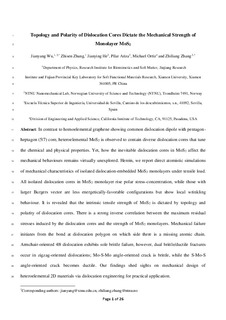| dc.contributor.author | Wu, Jianyang | |
| dc.contributor.author | Zhang, Zhisen | |
| dc.contributor.author | He, Jianying | |
| dc.contributor.author | Ariza, Pilar | |
| dc.contributor.author | Ortiz, Michael | |
| dc.contributor.author | Zhang, Zhiliang | |
| dc.date.accessioned | 2019-04-29T10:44:13Z | |
| dc.date.available | 2019-04-29T10:44:13Z | |
| dc.date.created | 2019-01-02T17:03:35Z | |
| dc.date.issued | 2019 | |
| dc.identifier.issn | 2352-9407 | |
| dc.identifier.uri | http://hdl.handle.net/11250/2595912 | |
| dc.description.abstract | In contrast to homoelemental graphene showing common dislocation dipole with pentagon-heptagon (5|7) core, heteroelemental MoS2 is observed to contain diverse dislocation cores that tune the chemical and physical properties. Yet, how the inevitable dislocation cores in MoS2 affect the mechanical behaviours remains virtually unexplored. Herein, we report direct atomistic simulations of mechanical characteristics of isolated dislocation-embedded MoS2 monolayers under tensile load. All isolated dislocation cores in MoS2 monolayer rise polar stress-concentration, while those with larger Burgers vector are less energetically-favorable configurations but show local wrinkling behaviour. It is revealed that the intrinsic tensile strength of MoS2 is dictated by topology and polarity of dislocation cores. There is a strong inverse correlation between the maximum residual stresses induced by the dislocation cores and the strength of MoS2 monolayers. Mechanical failure initiates from the bond at dislocation polygon on which side there is a missing atomic chain. Armchair-oriented 4|8 dislocation exhibits sole brittle failure, however, dual brittle/ductile fractures occur in zigzag-oriented dislocations; Mo-S-Mo angle-oriented crack is brittle, while the S-Mo-S angle-oriented crack becomes ductile. Our findings shed sights on mechanical design of heteroelemental 2D materials via dislocation engineering for practical application. | nb_NO |
| dc.language.iso | eng | nb_NO |
| dc.publisher | Elsevier | nb_NO |
| dc.rights | Attribution-NonCommercial-NoDerivatives 4.0 Internasjonal | * |
| dc.rights.uri | http://creativecommons.org/licenses/by-nc-nd/4.0/deed.no | * |
| dc.title | Topology and polarity of dislocation cores dictate the strength of monolayer MoS2 | nb_NO |
| dc.type | Journal article | nb_NO |
| dc.type | Peer reviewed | nb_NO |
| dc.description.version | acceptedVersion | nb_NO |
| dc.source.volume | 15 | nb_NO |
| dc.source.journal | Applied Materials Today | nb_NO |
| dc.identifier.doi | 10.1016/j.apmt.2018.12.019 | |
| dc.identifier.cristin | 1648972 | |
| dc.relation.project | Notur/NorStore: NN9110K | nb_NO |
| dc.relation.project | Notur/NorStore: NN9391K | nb_NO |
| dc.description.localcode | © 2019. This is the authors’ accepted and refereed manuscript to the article. Locked until 12.1.2021 due to copyright restrictions. This manuscript version is made available under the CC-BY-NC-ND 4.0 license http://creativecommons.org/licenses/by-nc-nd/4.0/ | nb_NO |
| cristin.unitcode | 194,64,45,0 | |
| cristin.unitname | Institutt for konstruksjonsteknikk | |
| cristin.ispublished | true | |
| cristin.fulltext | postprint | |

